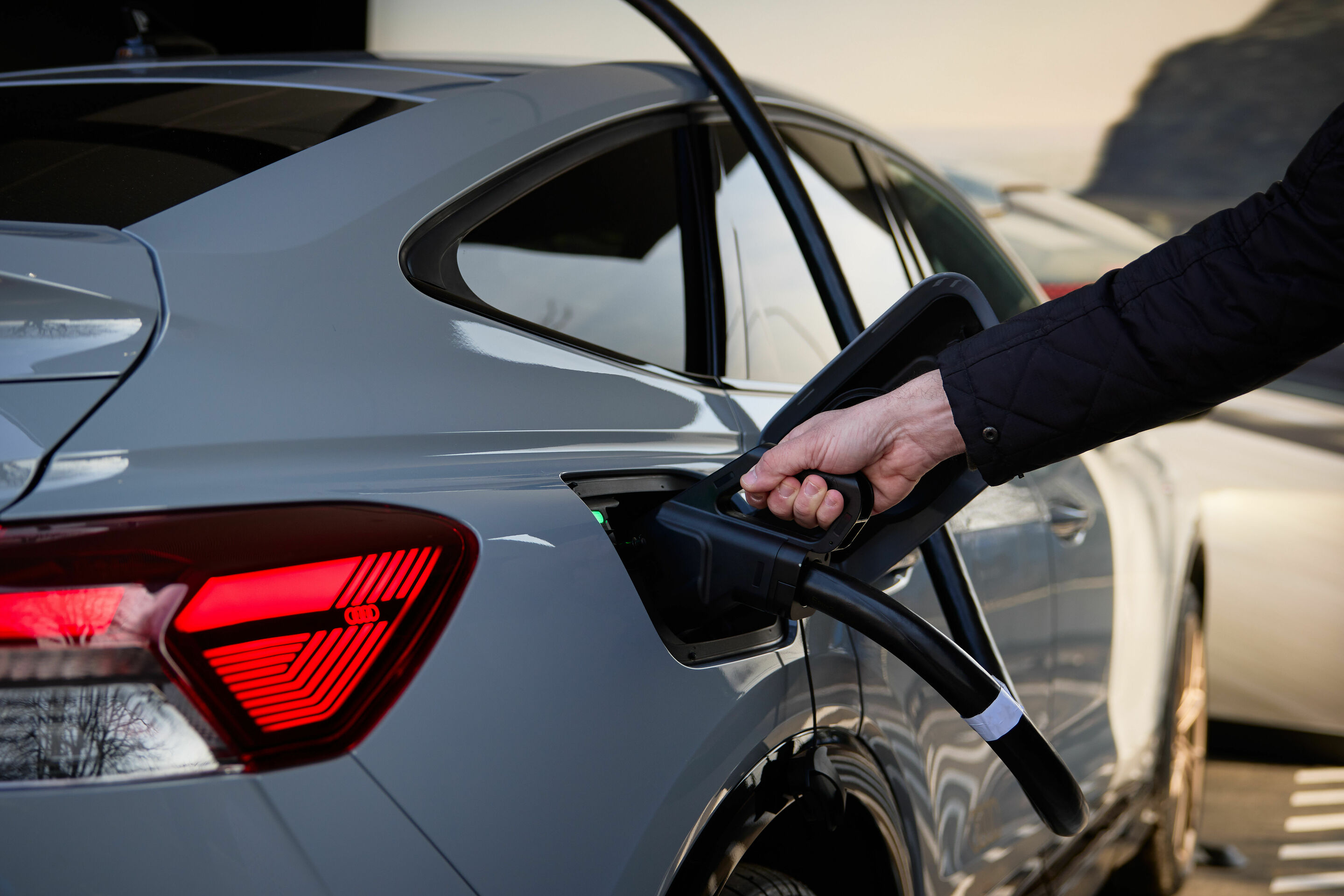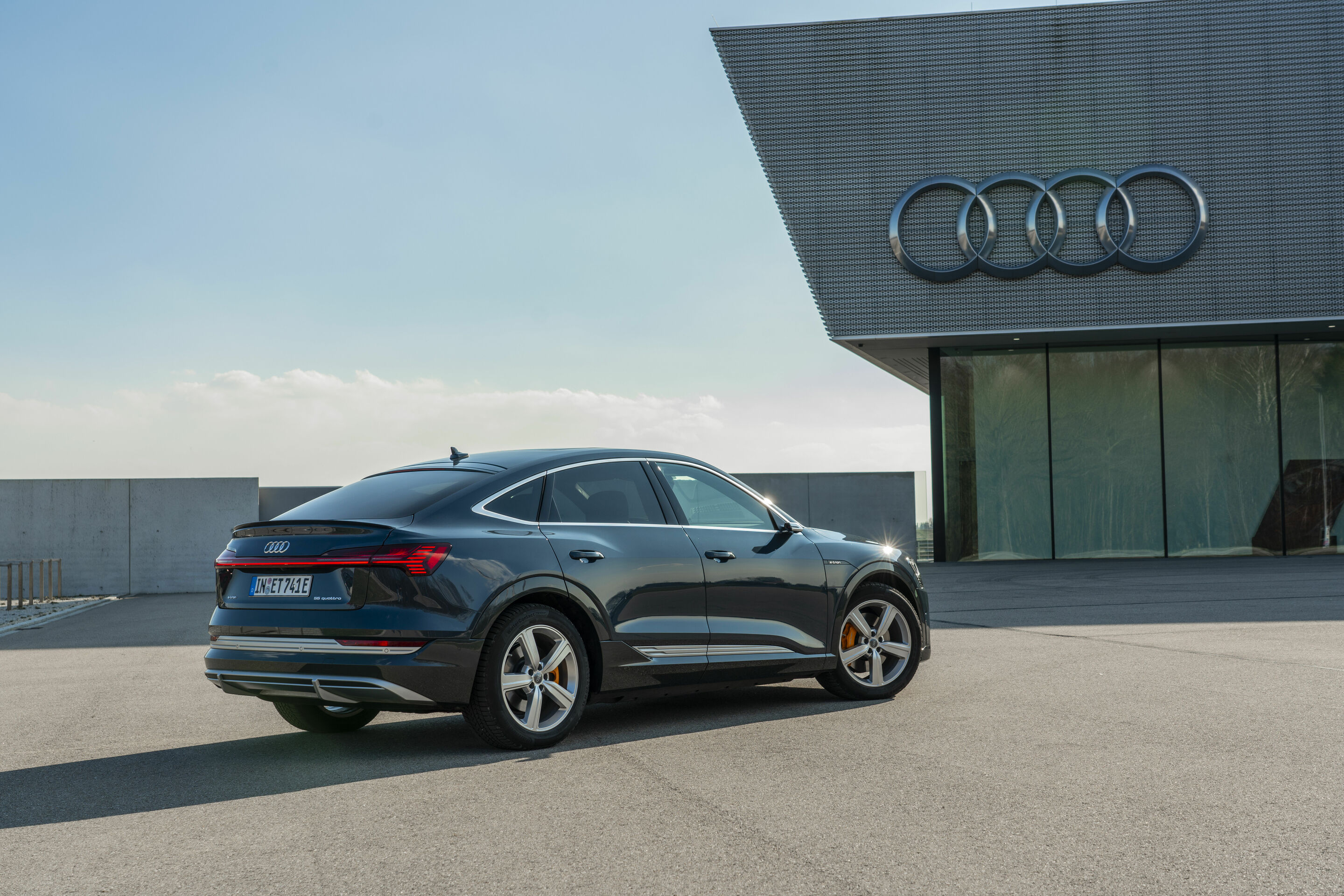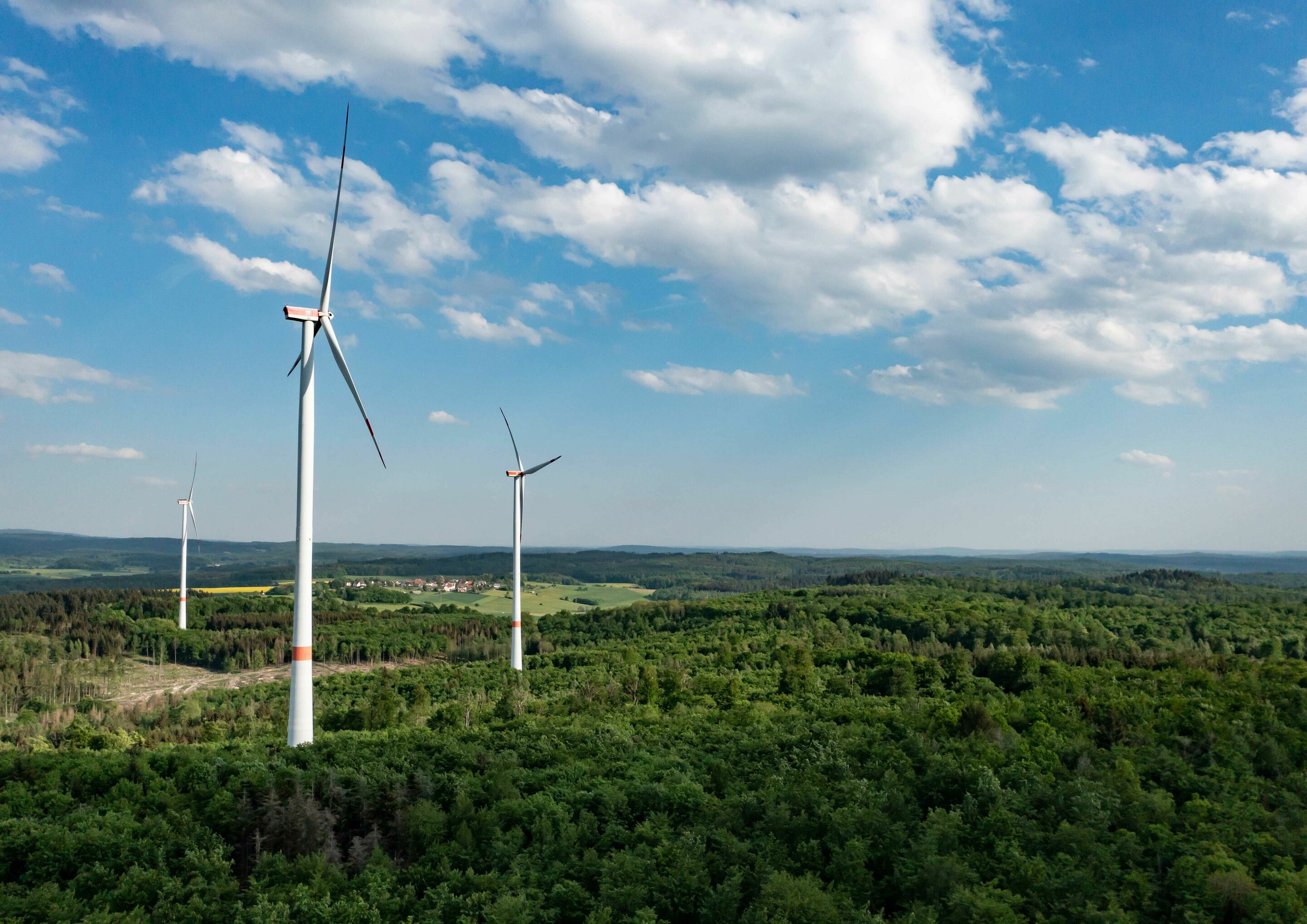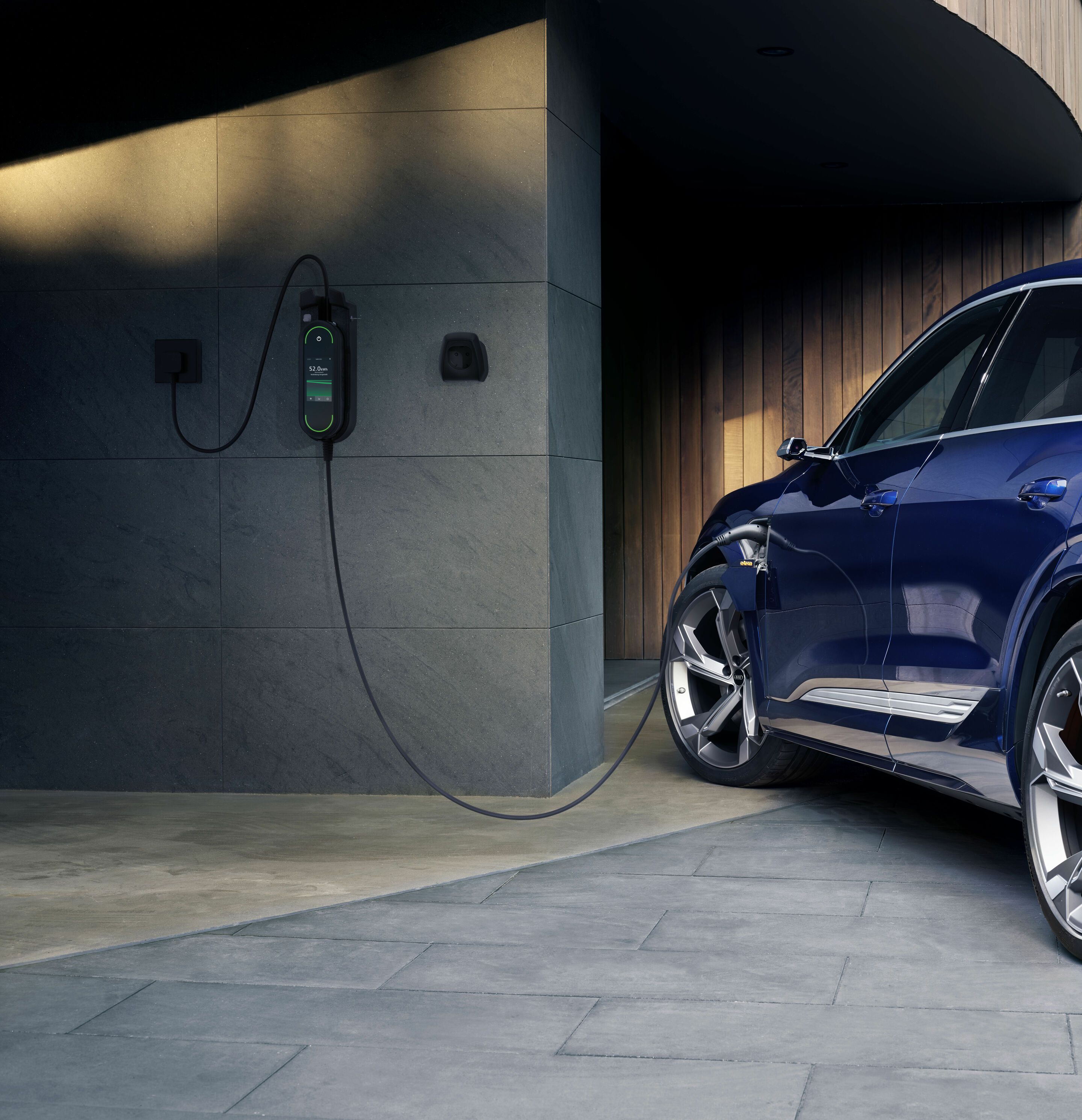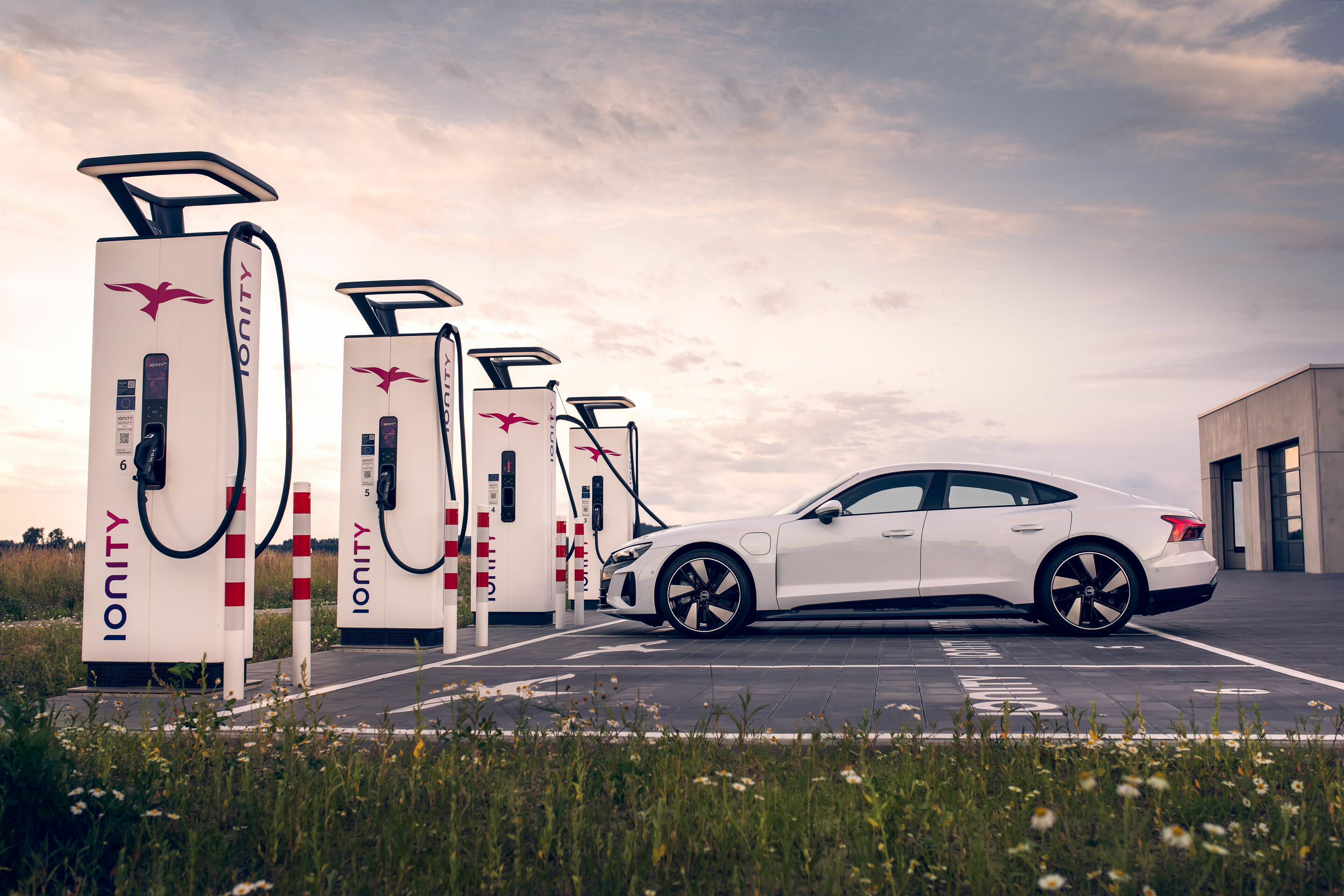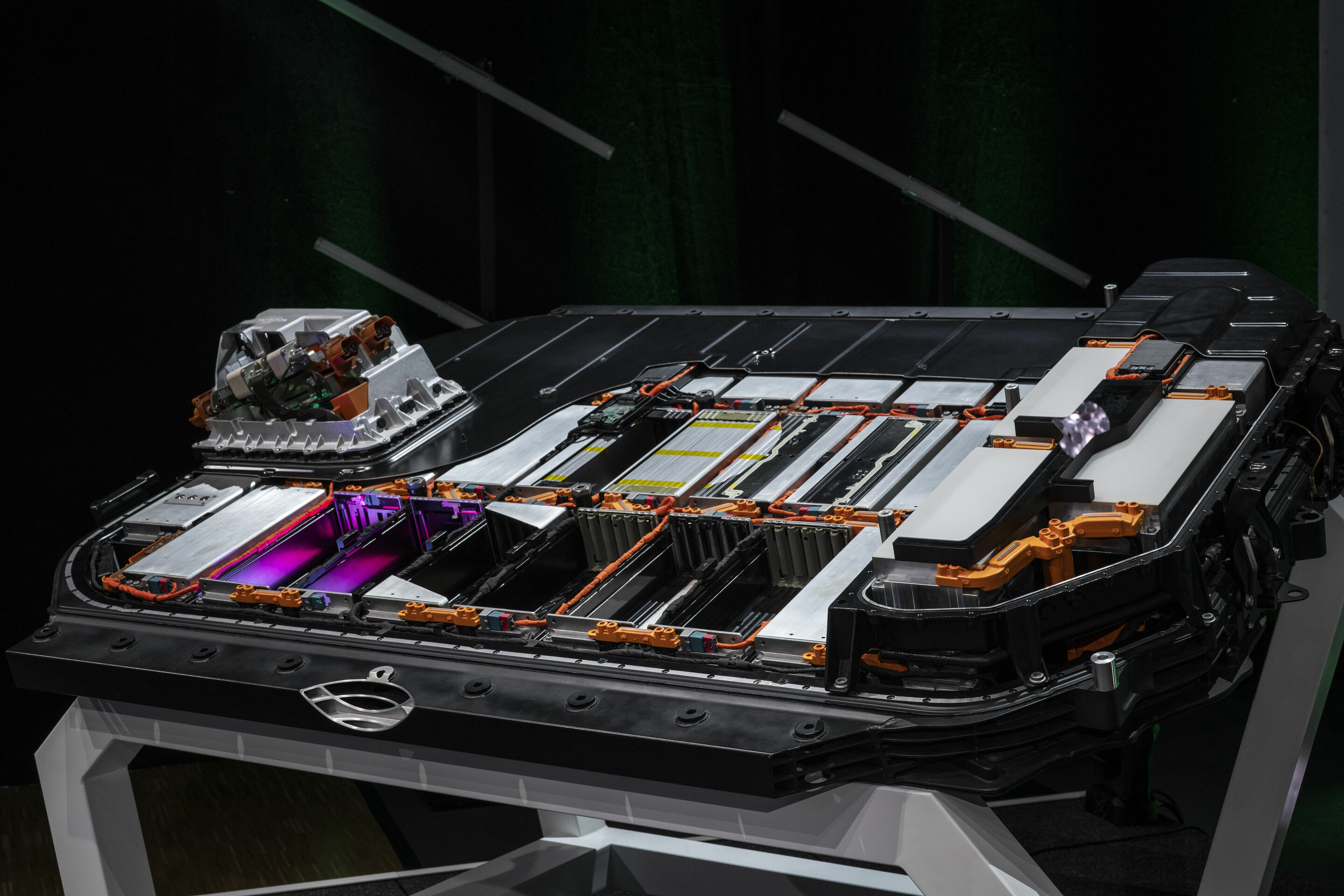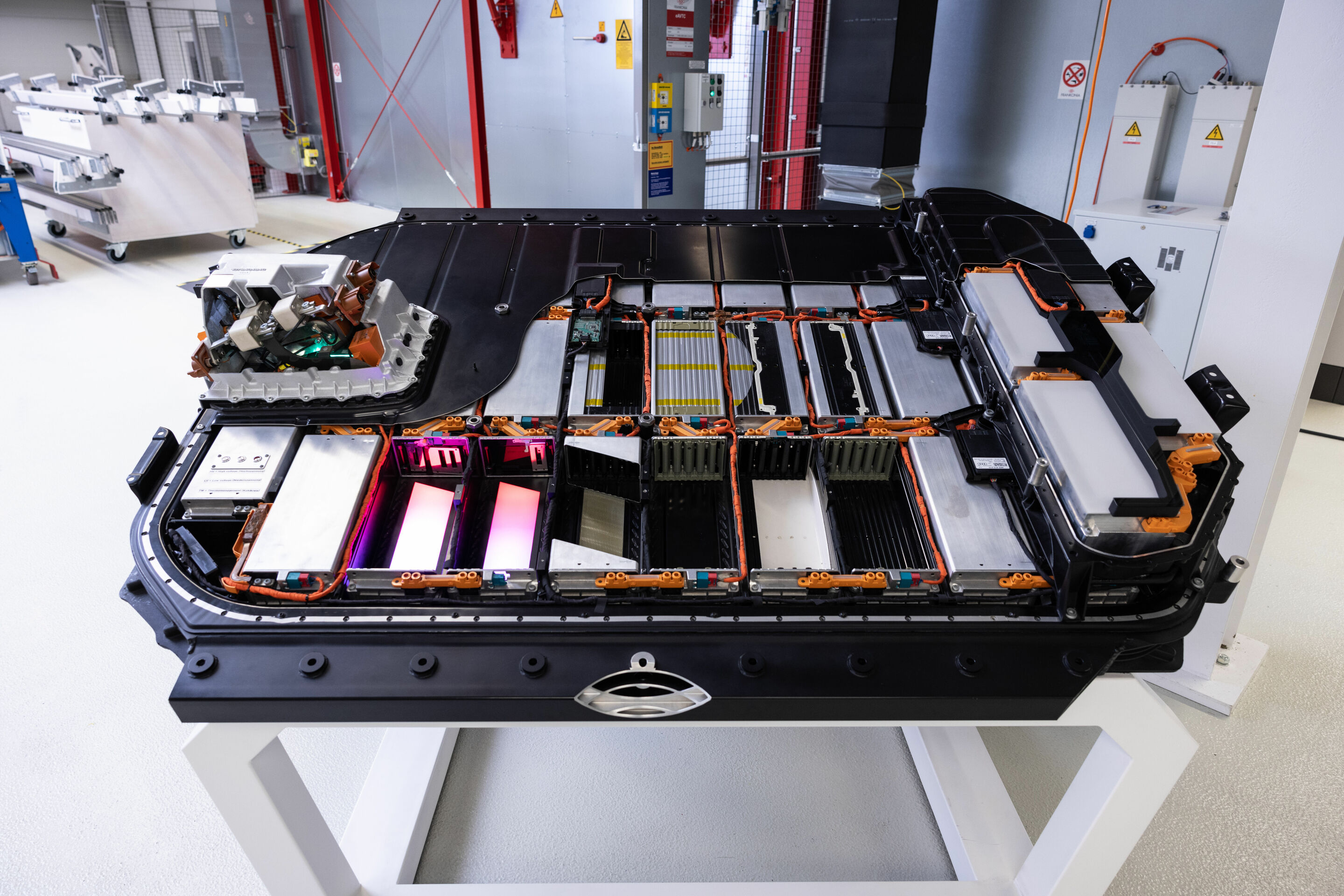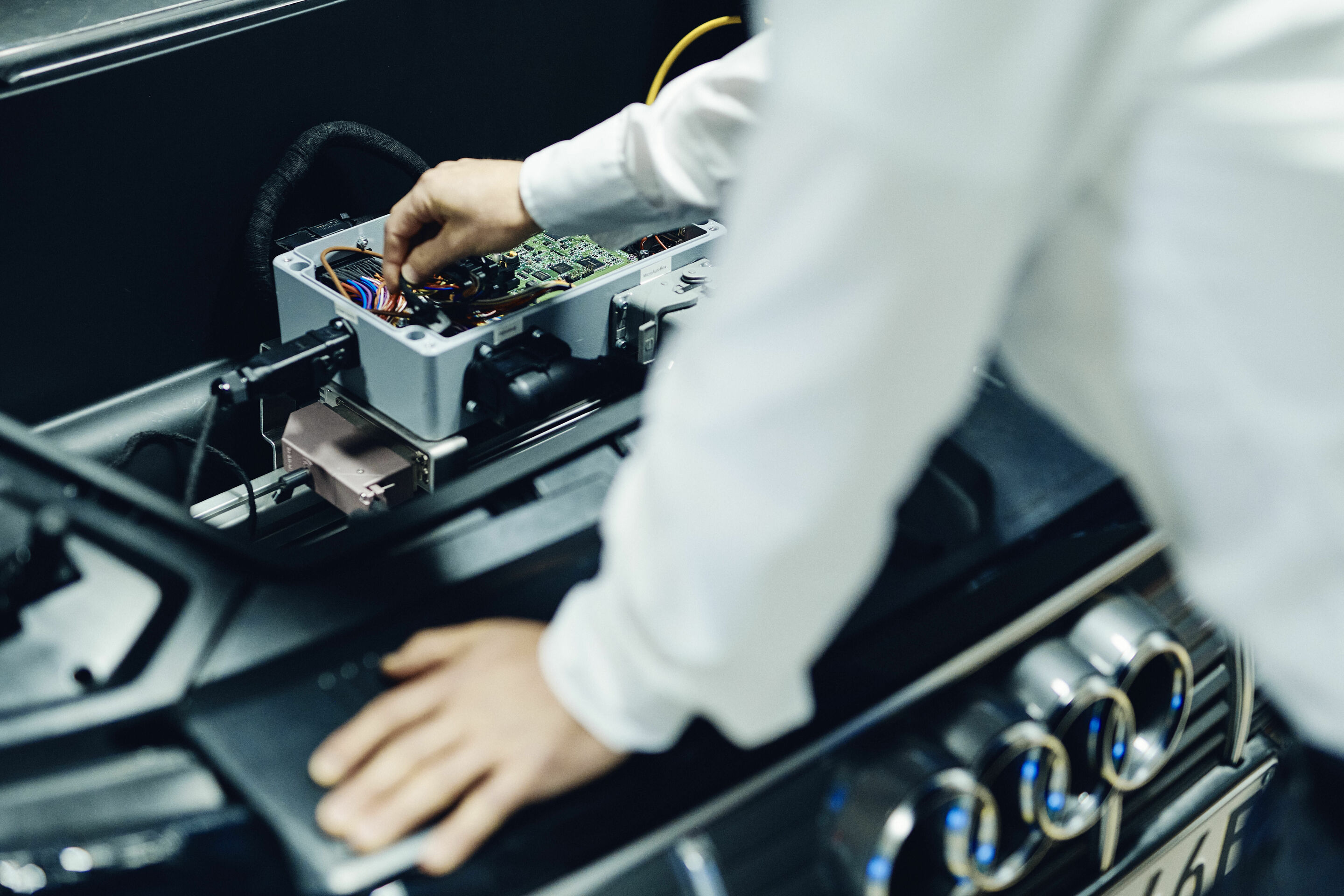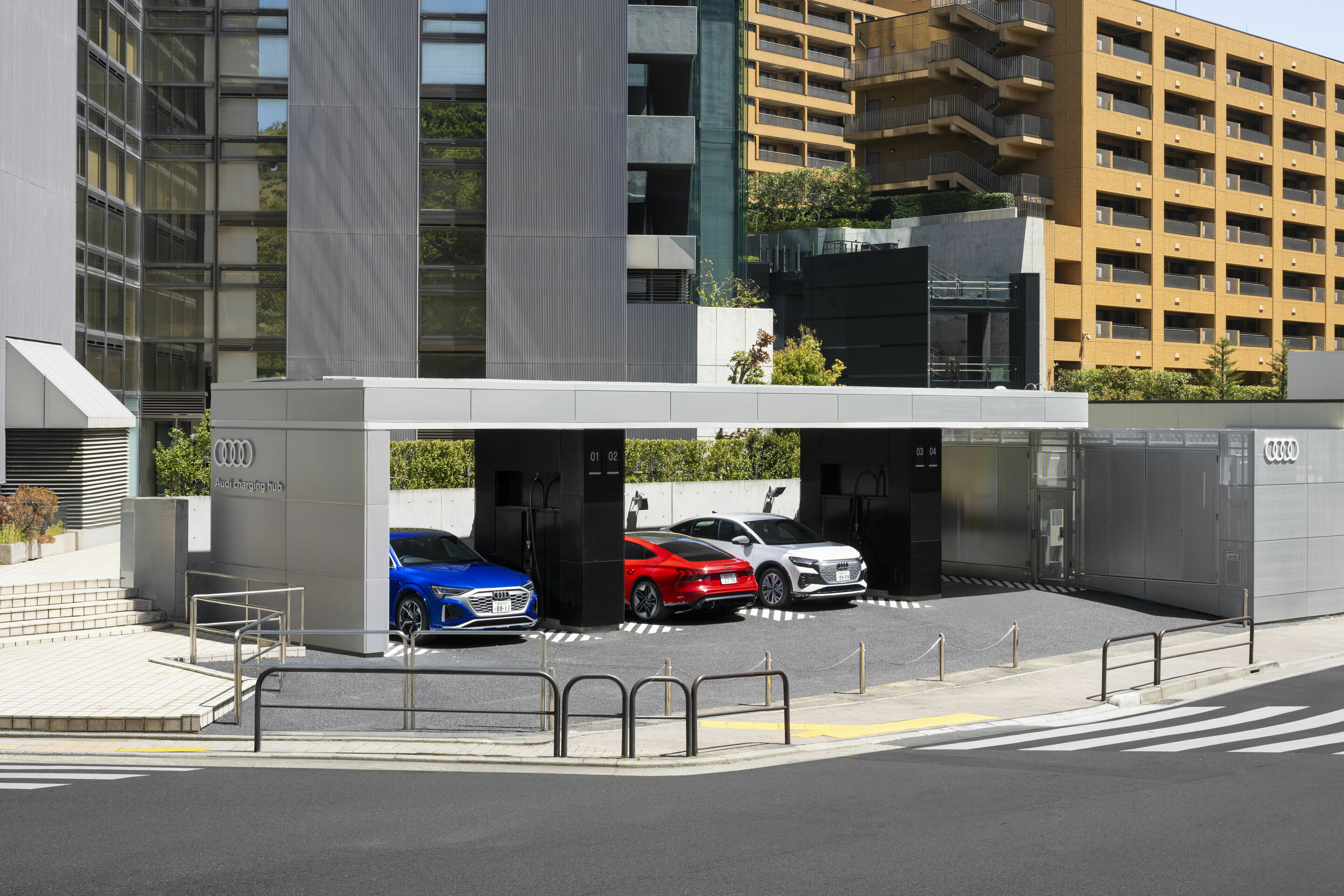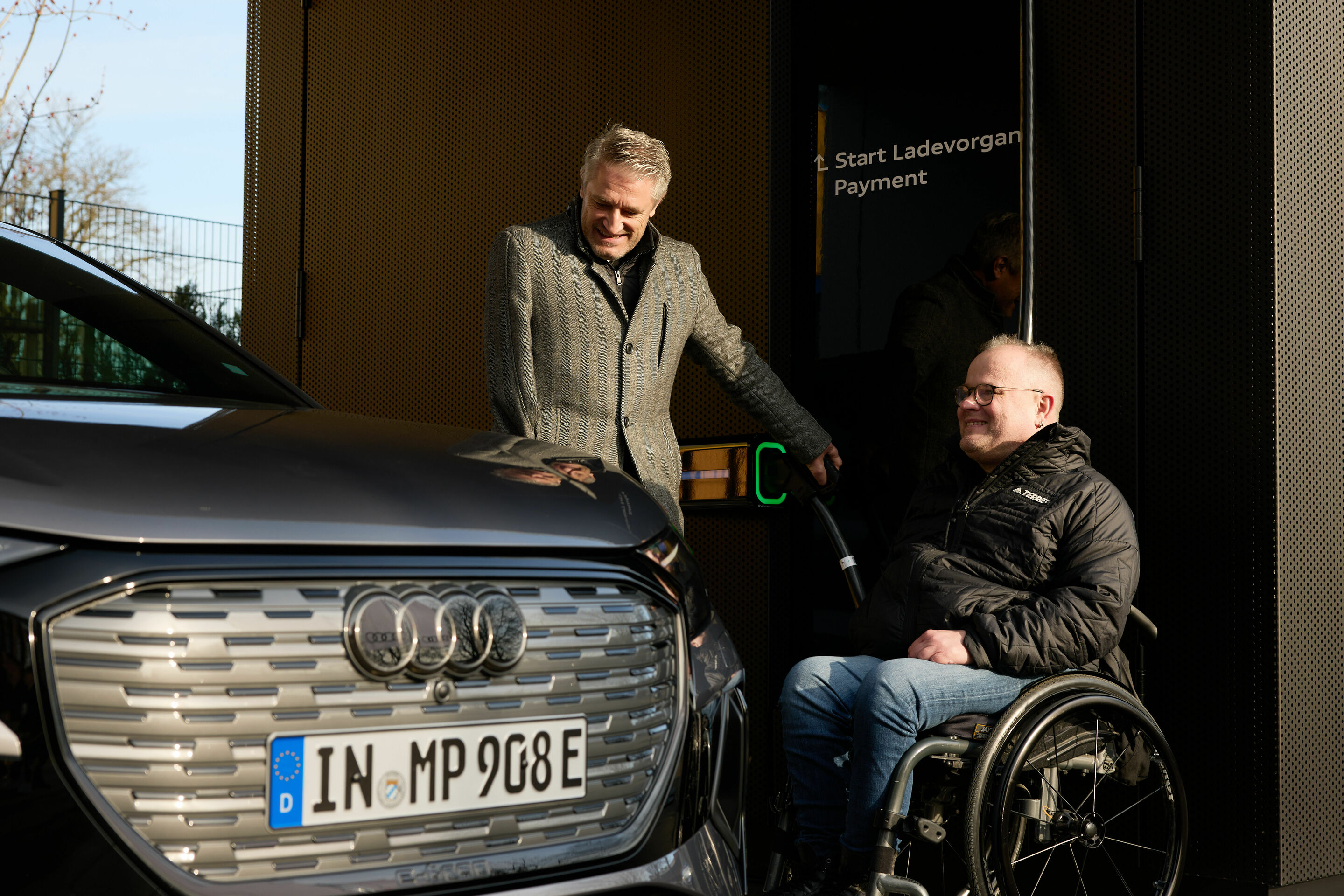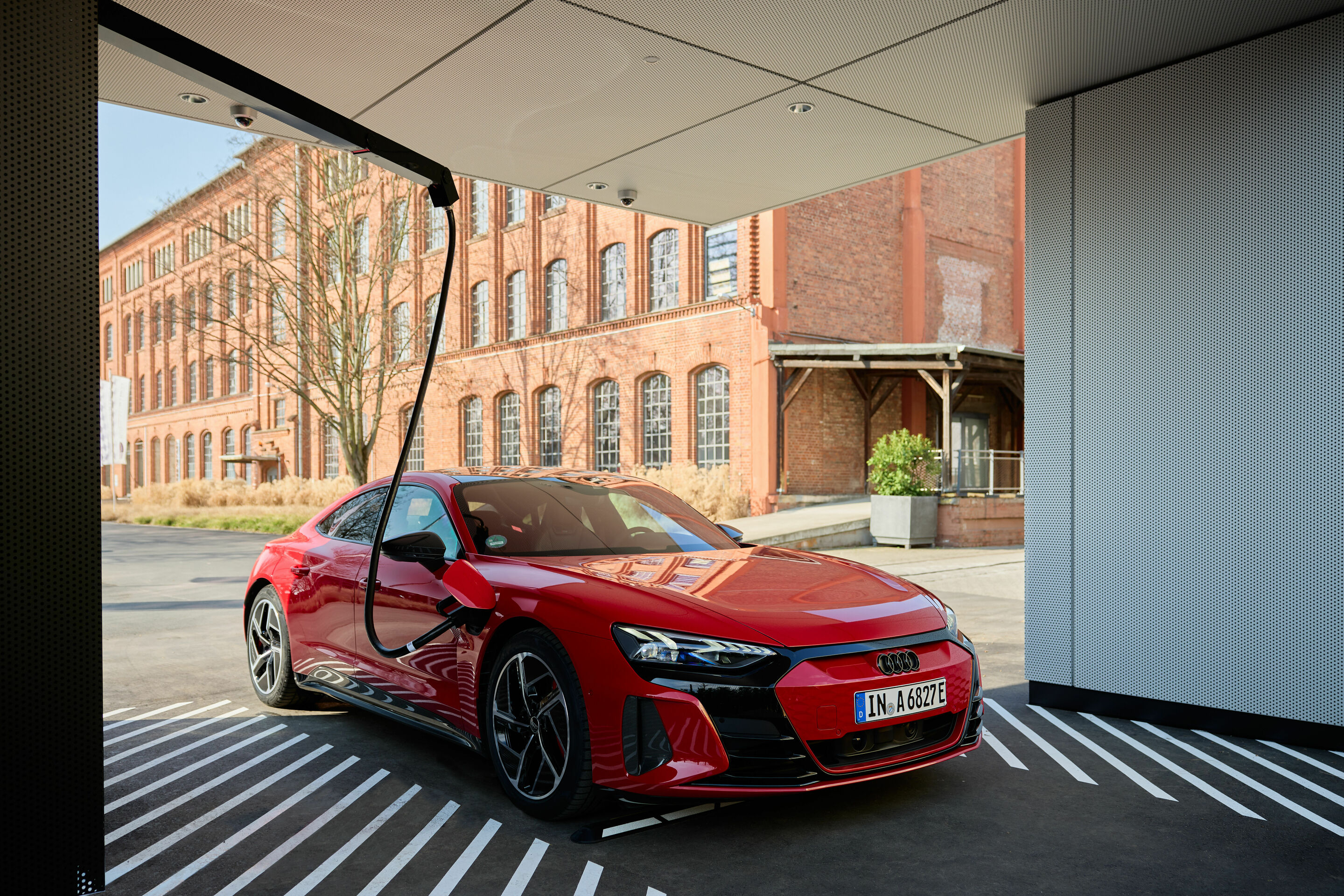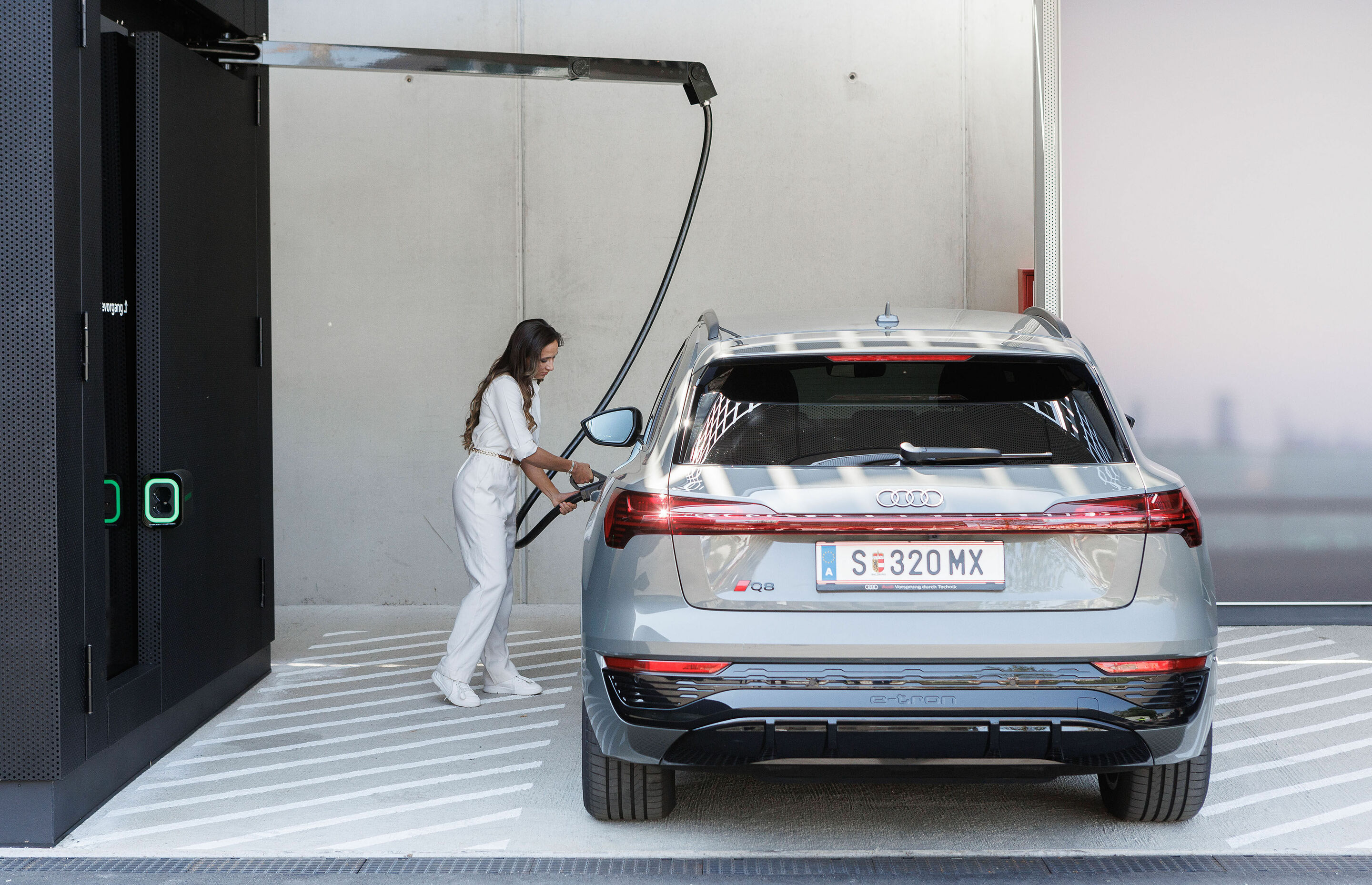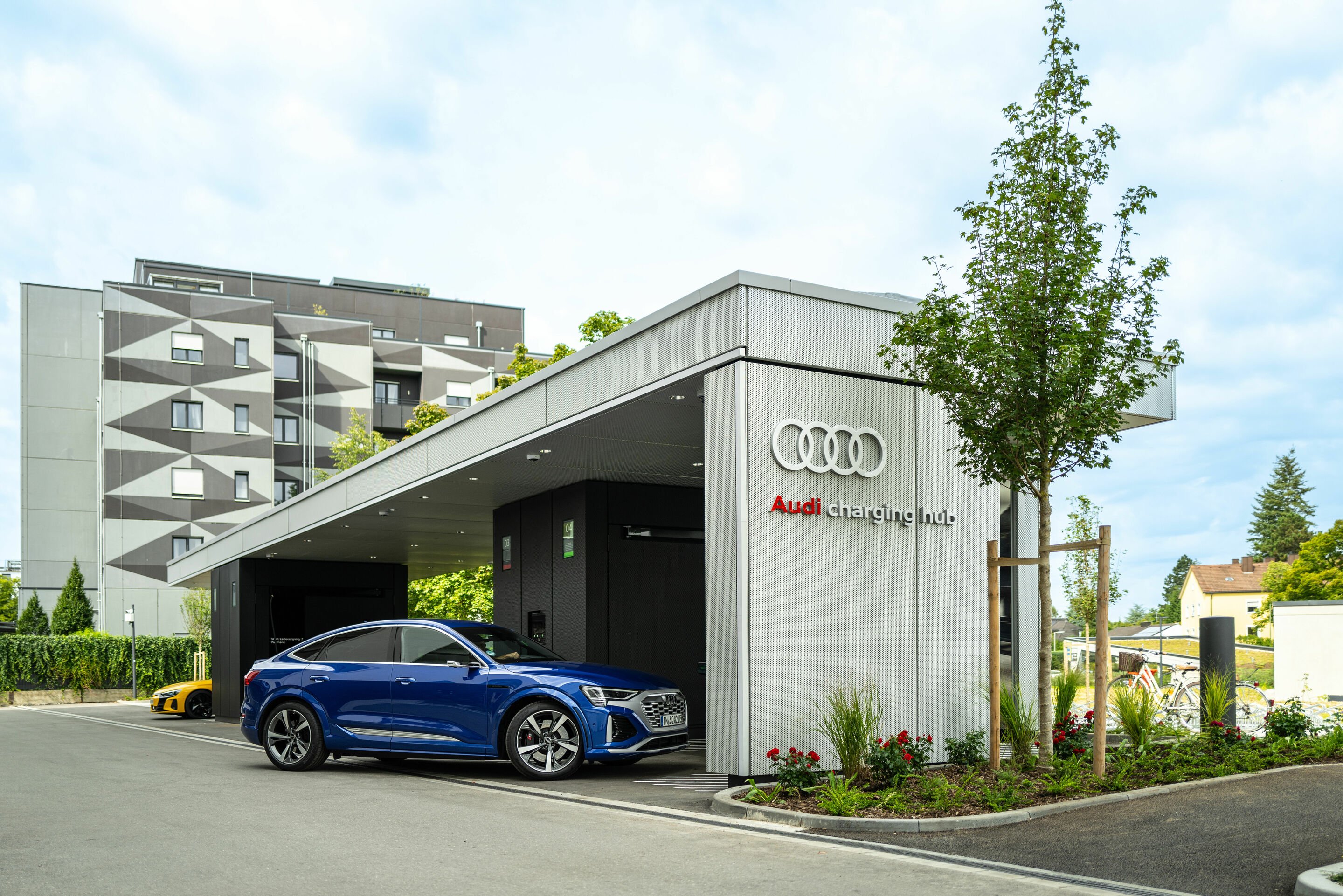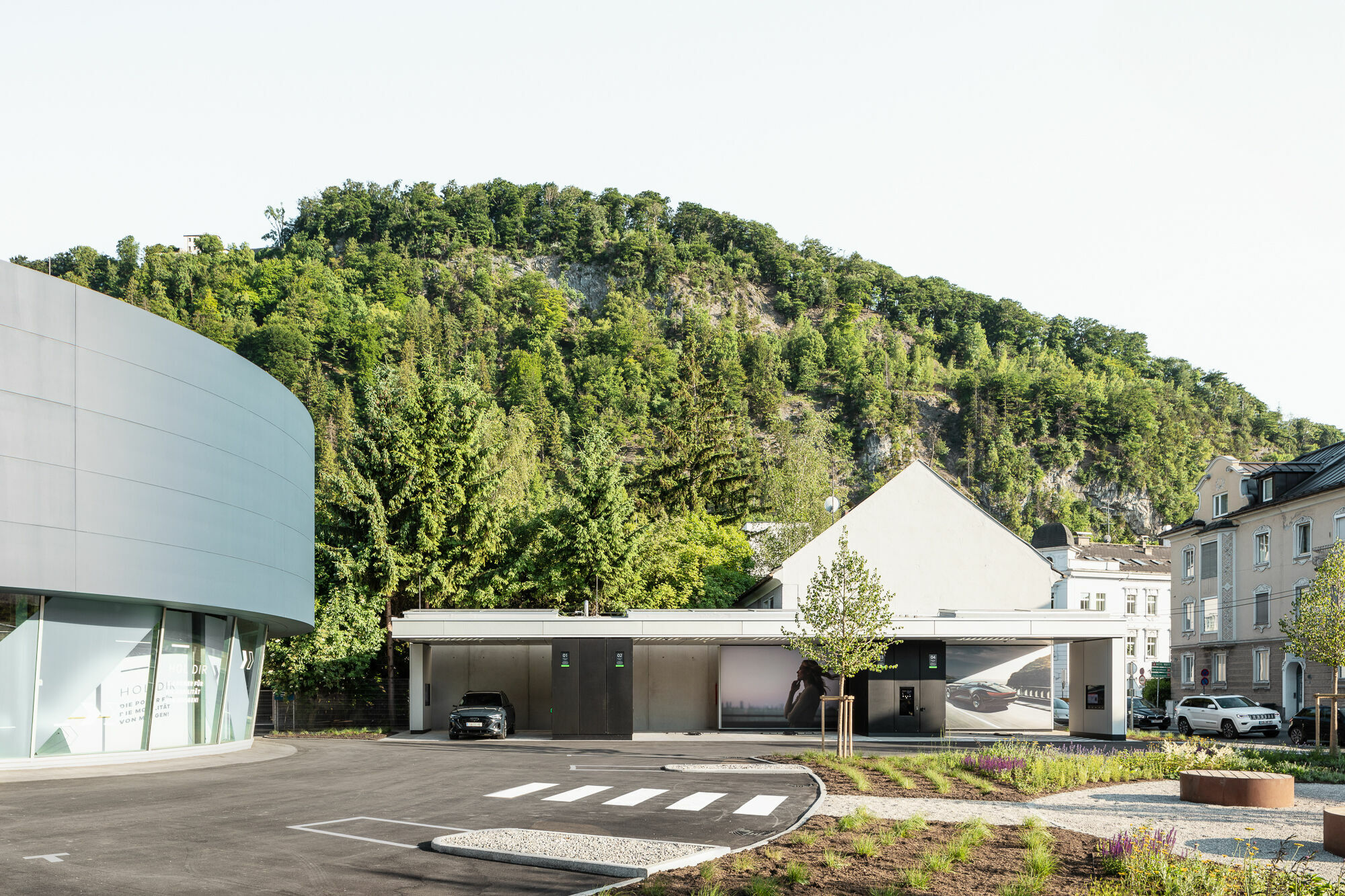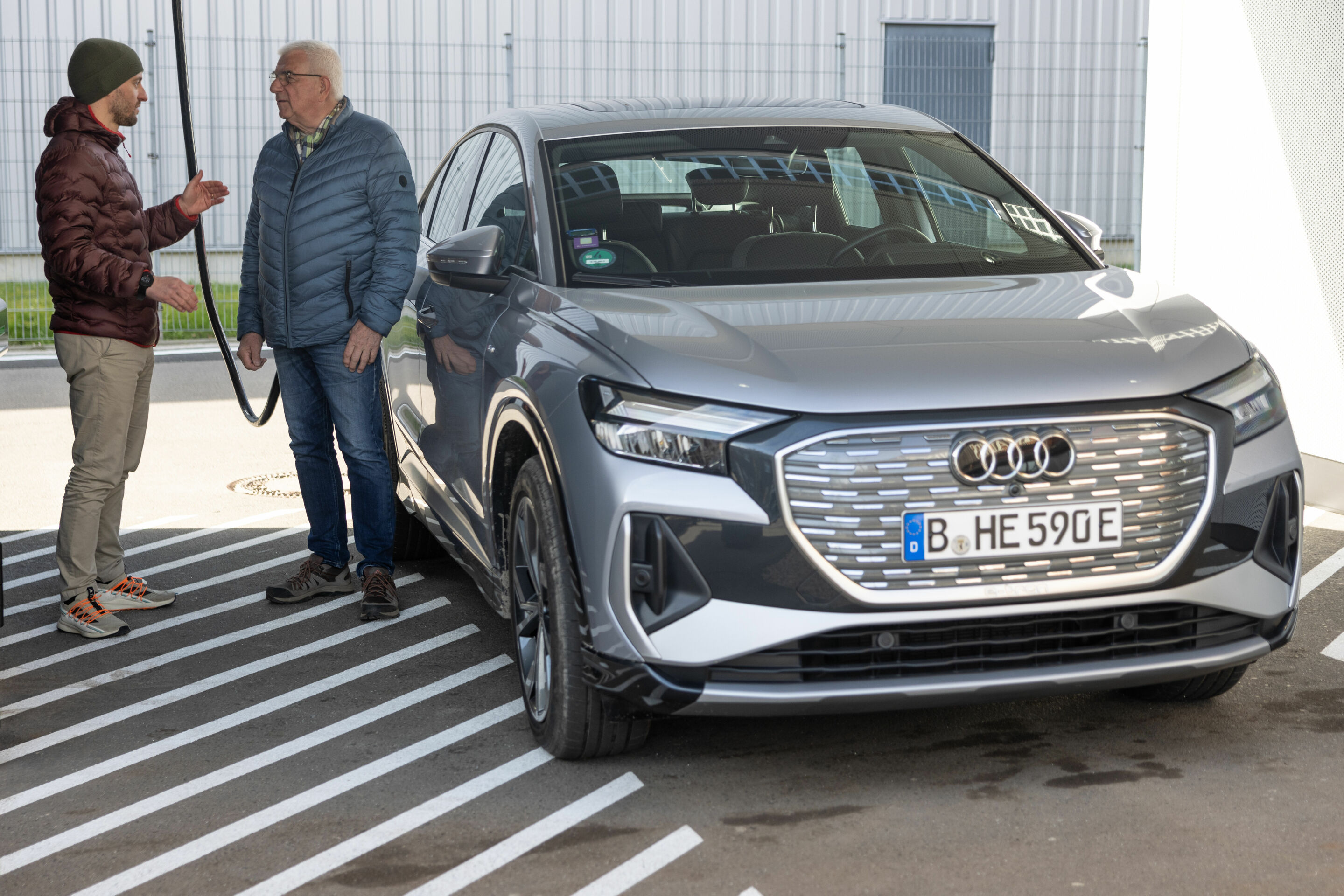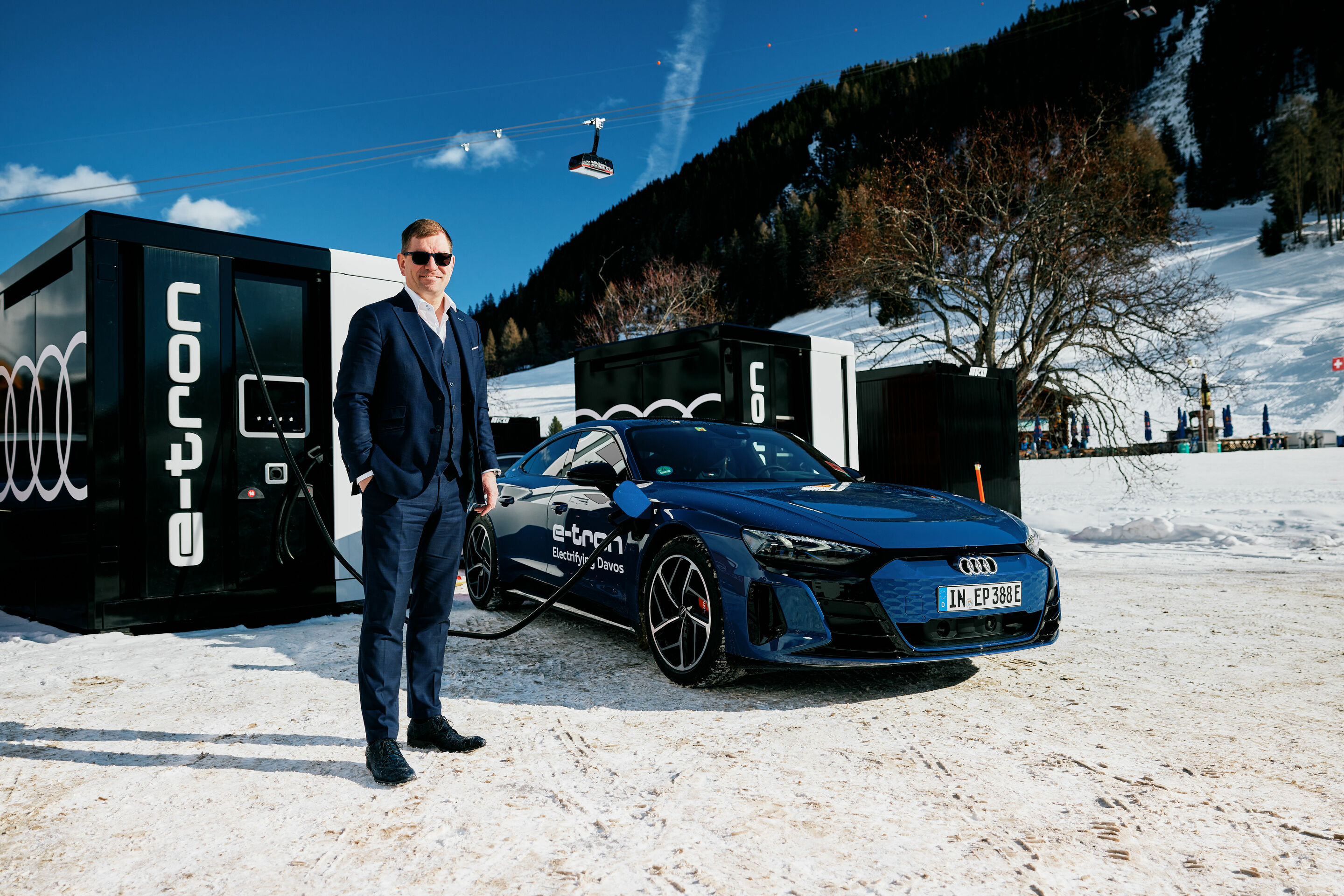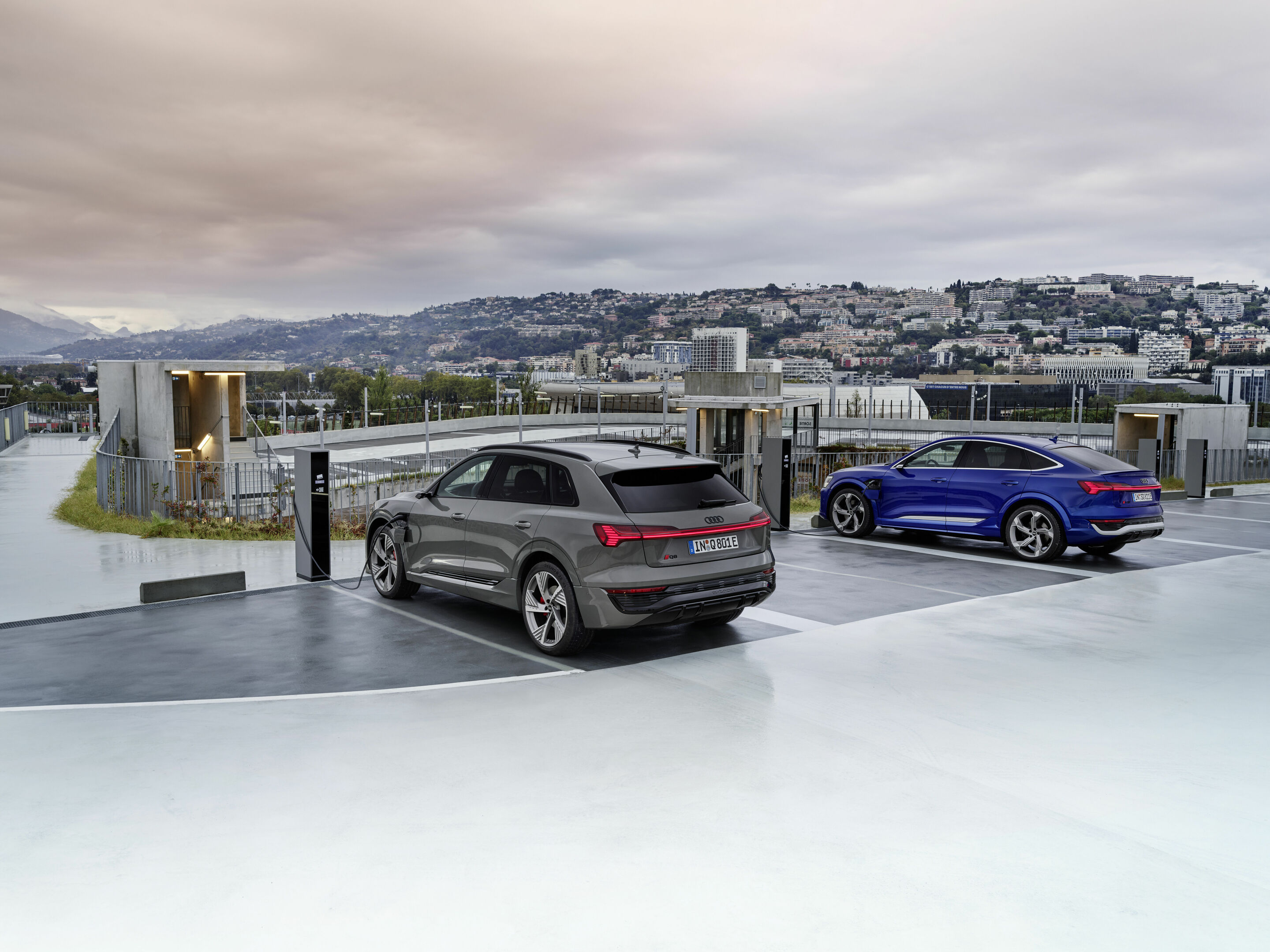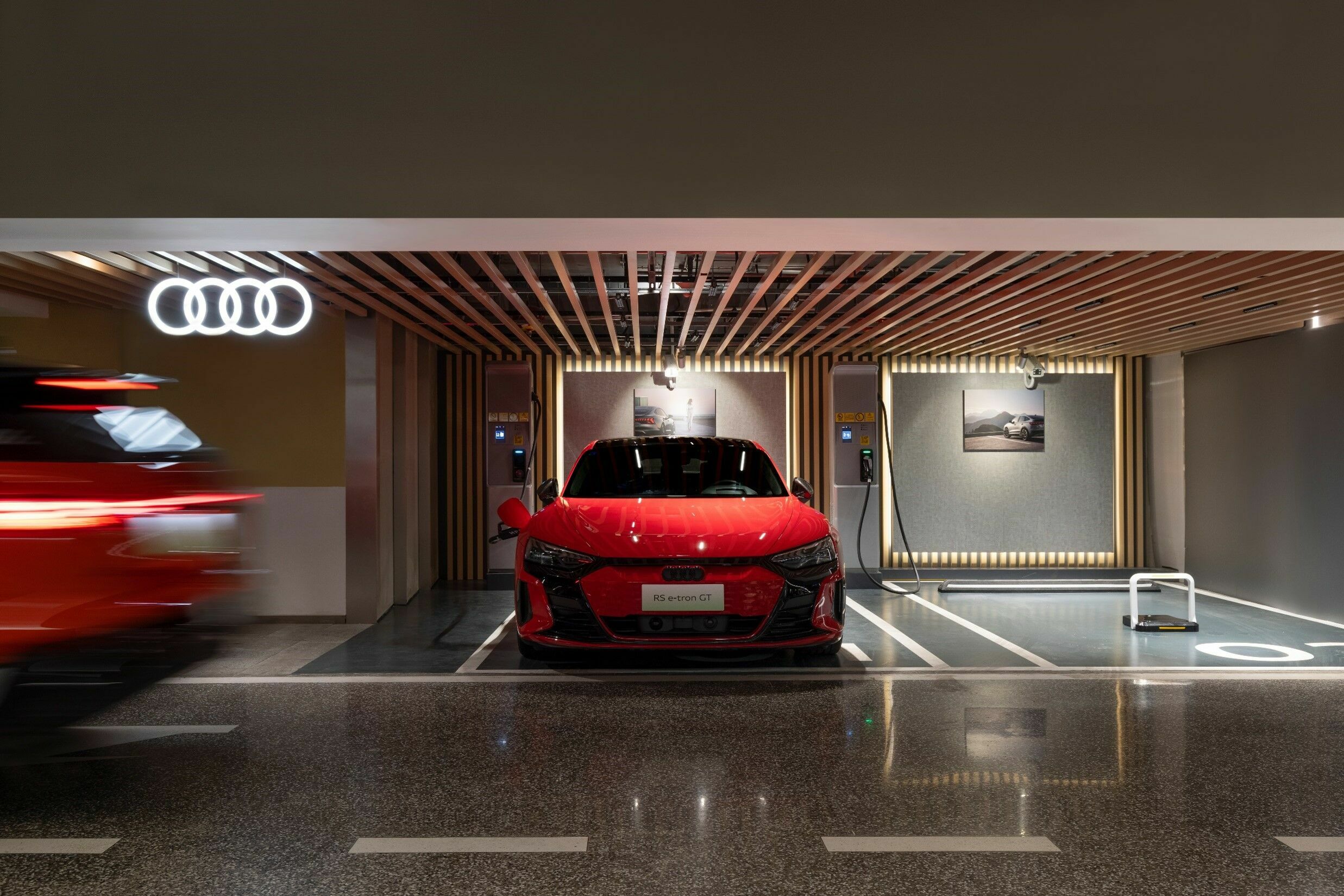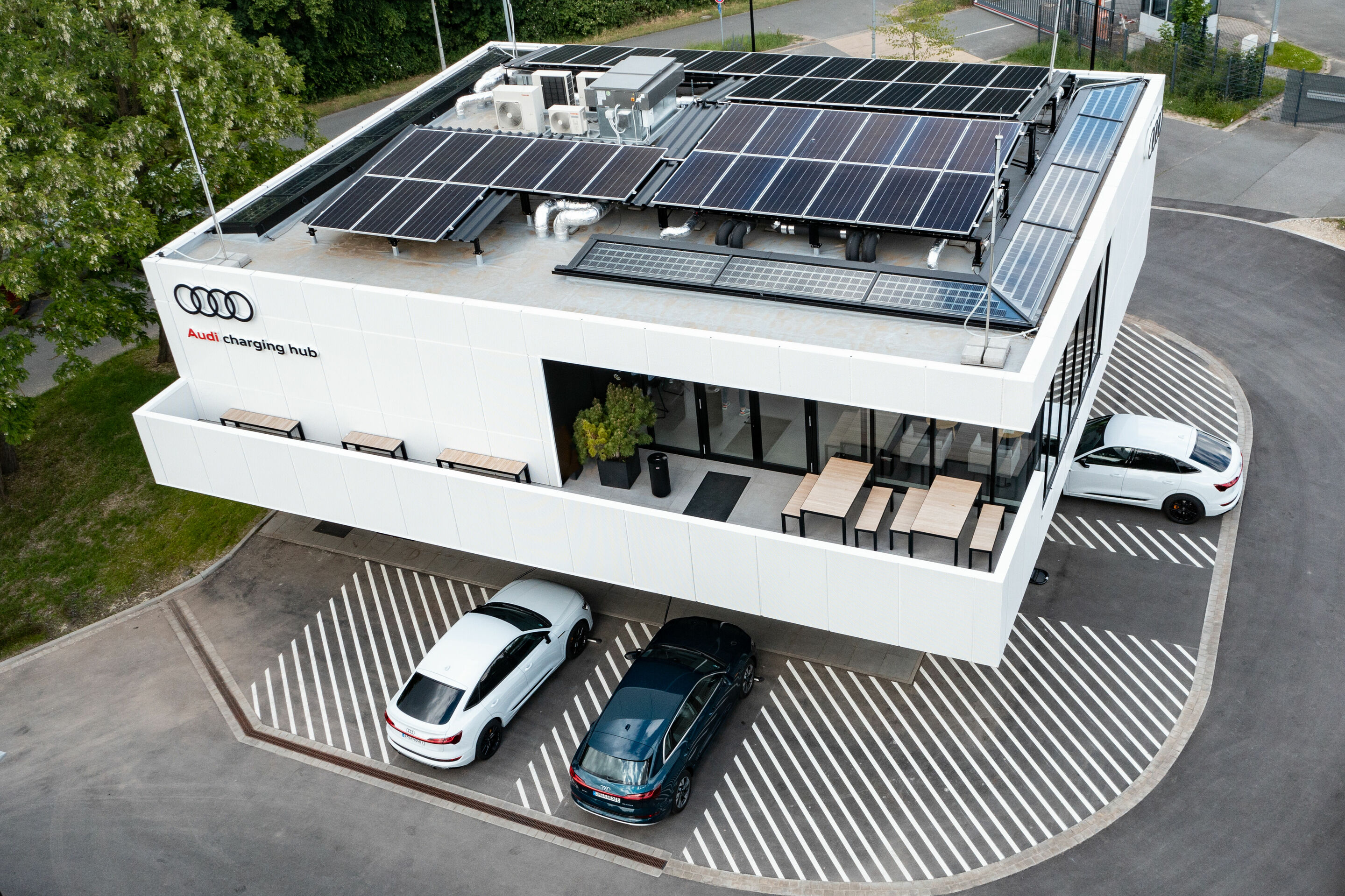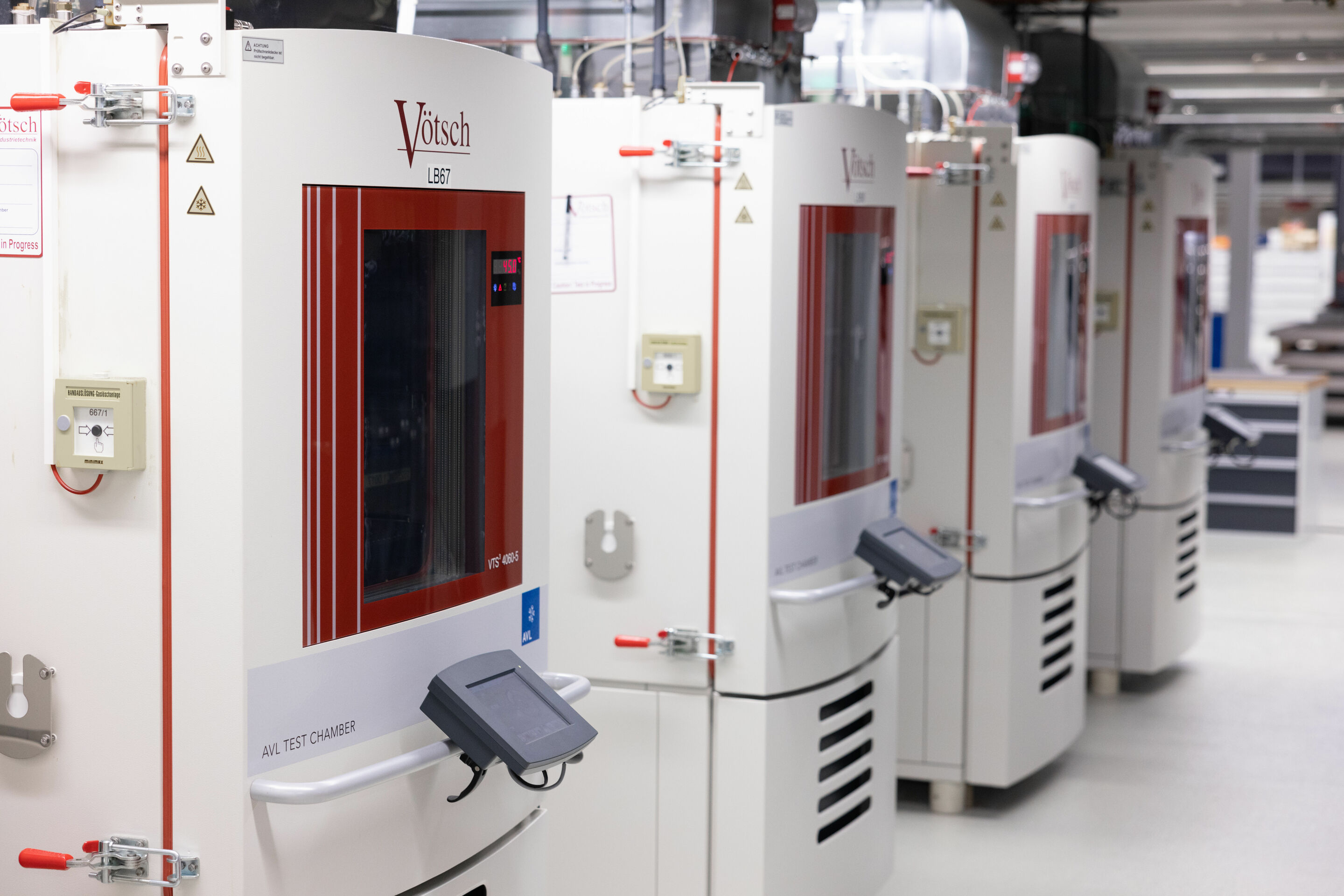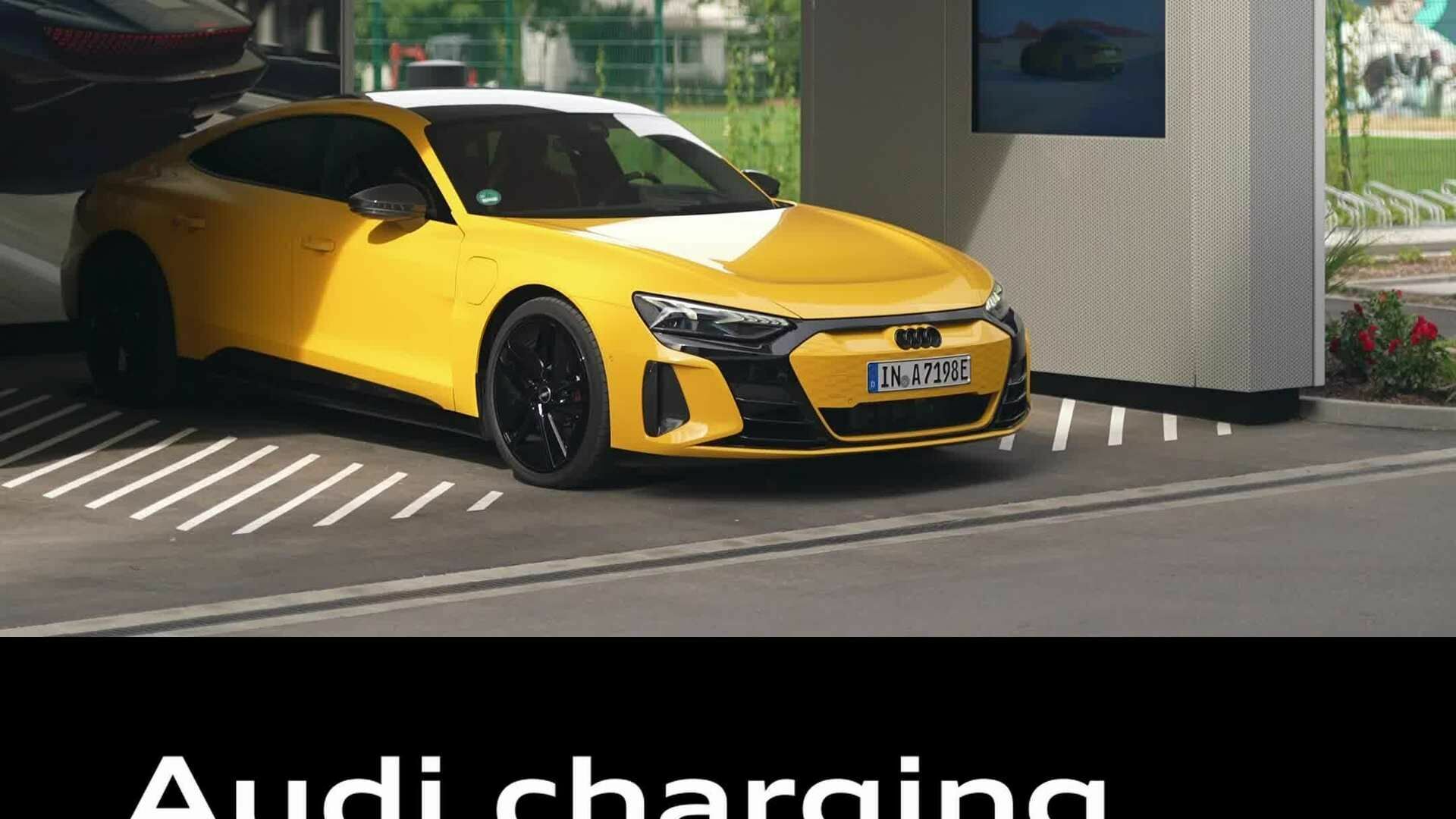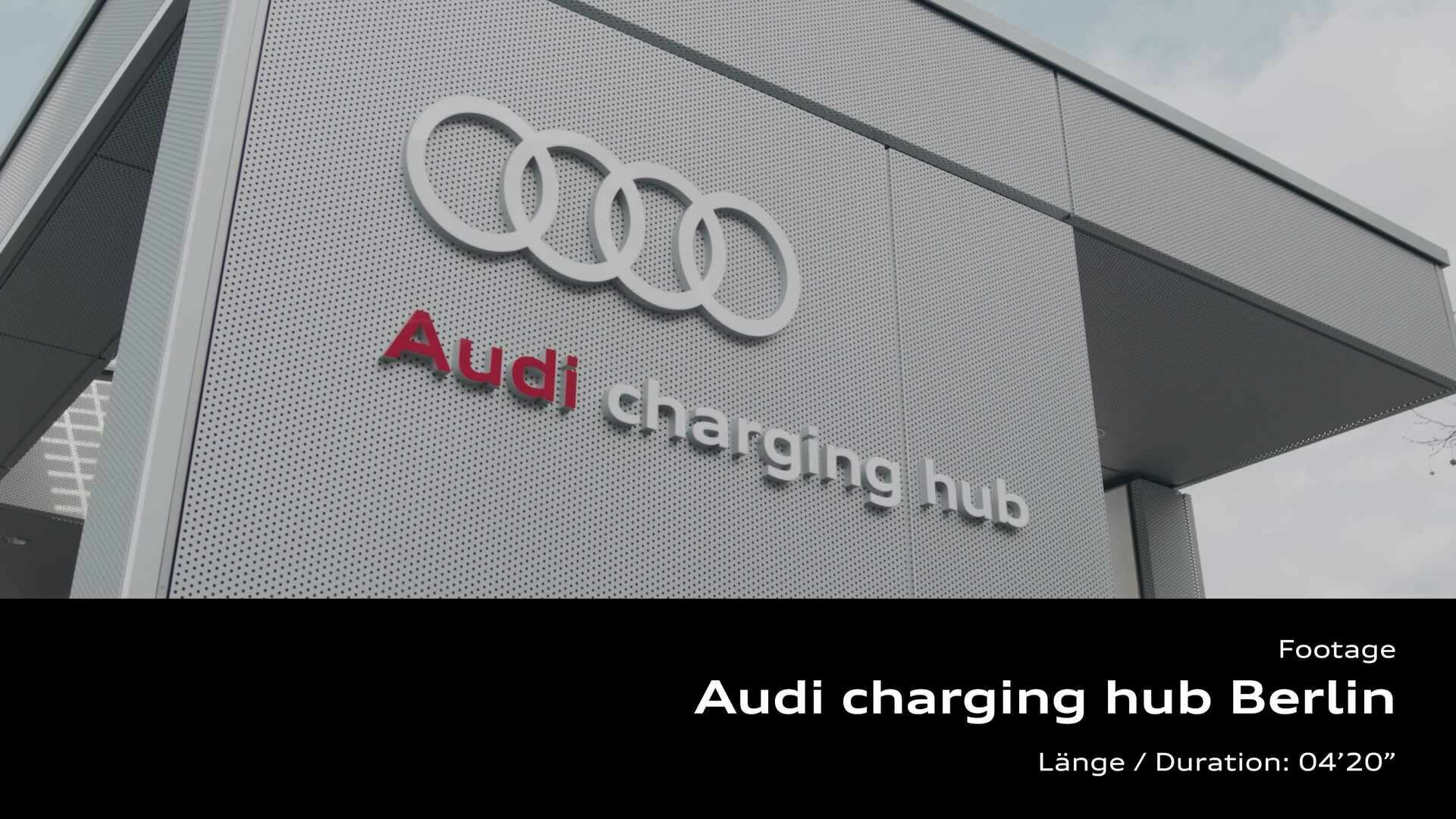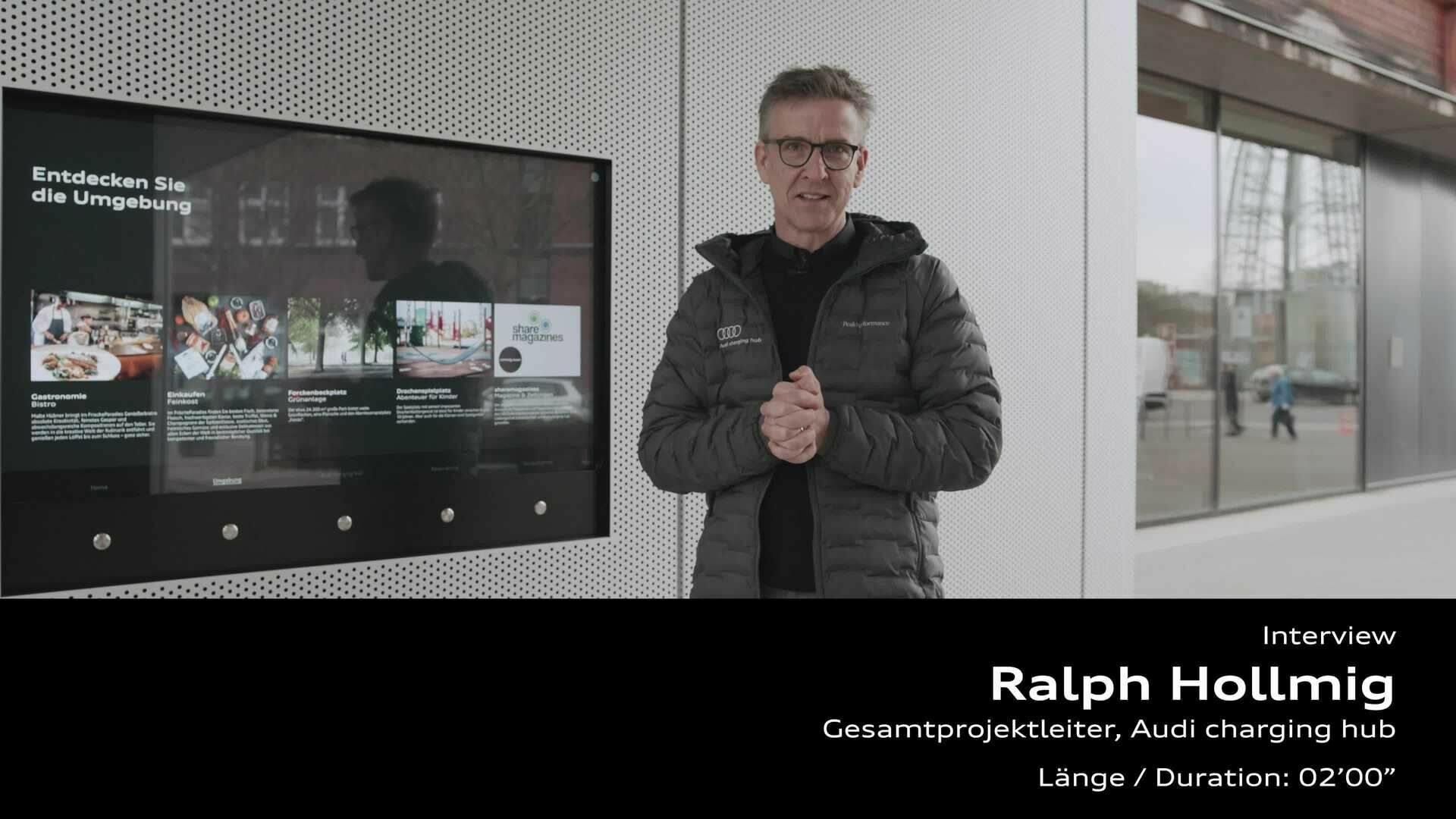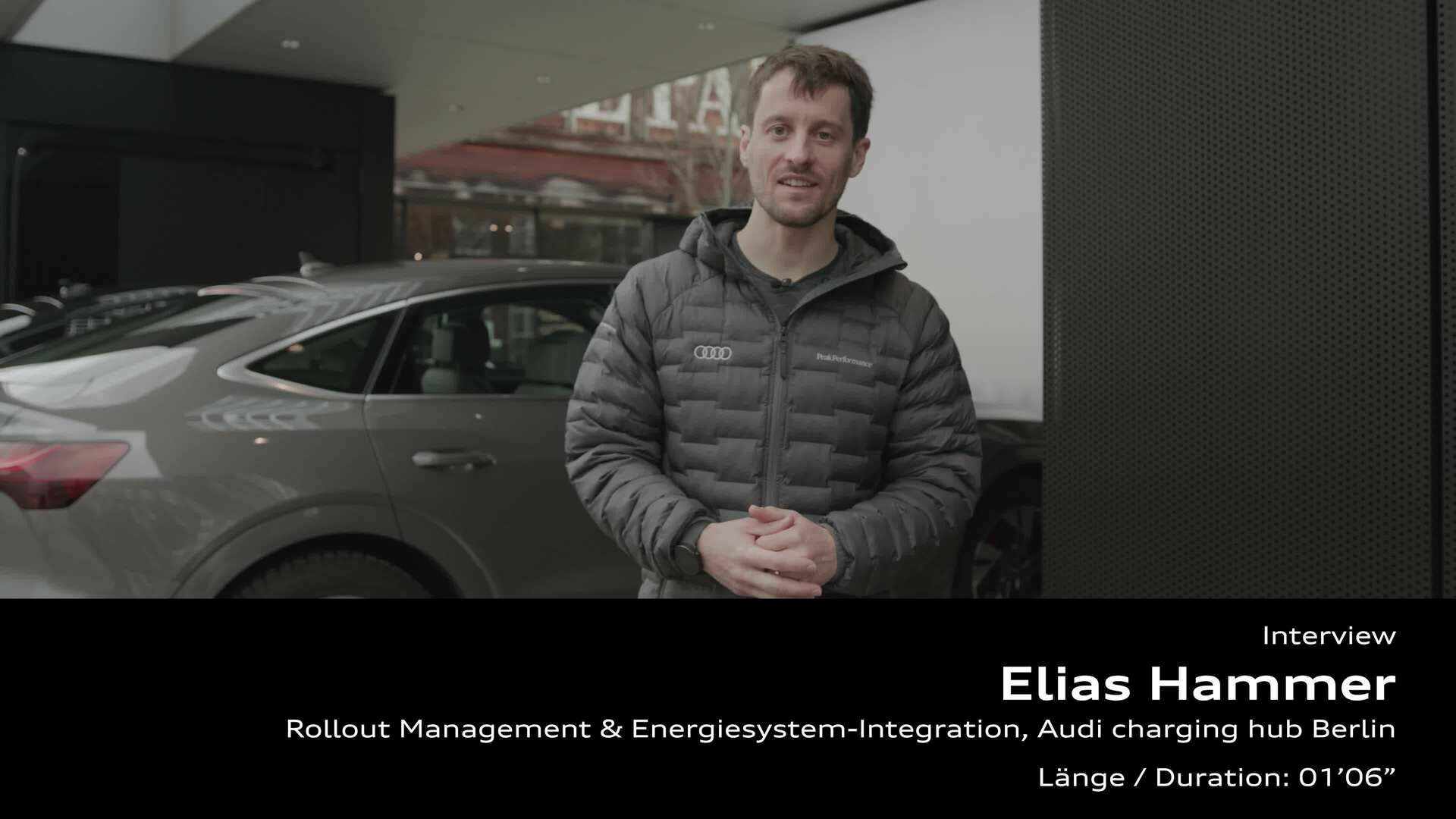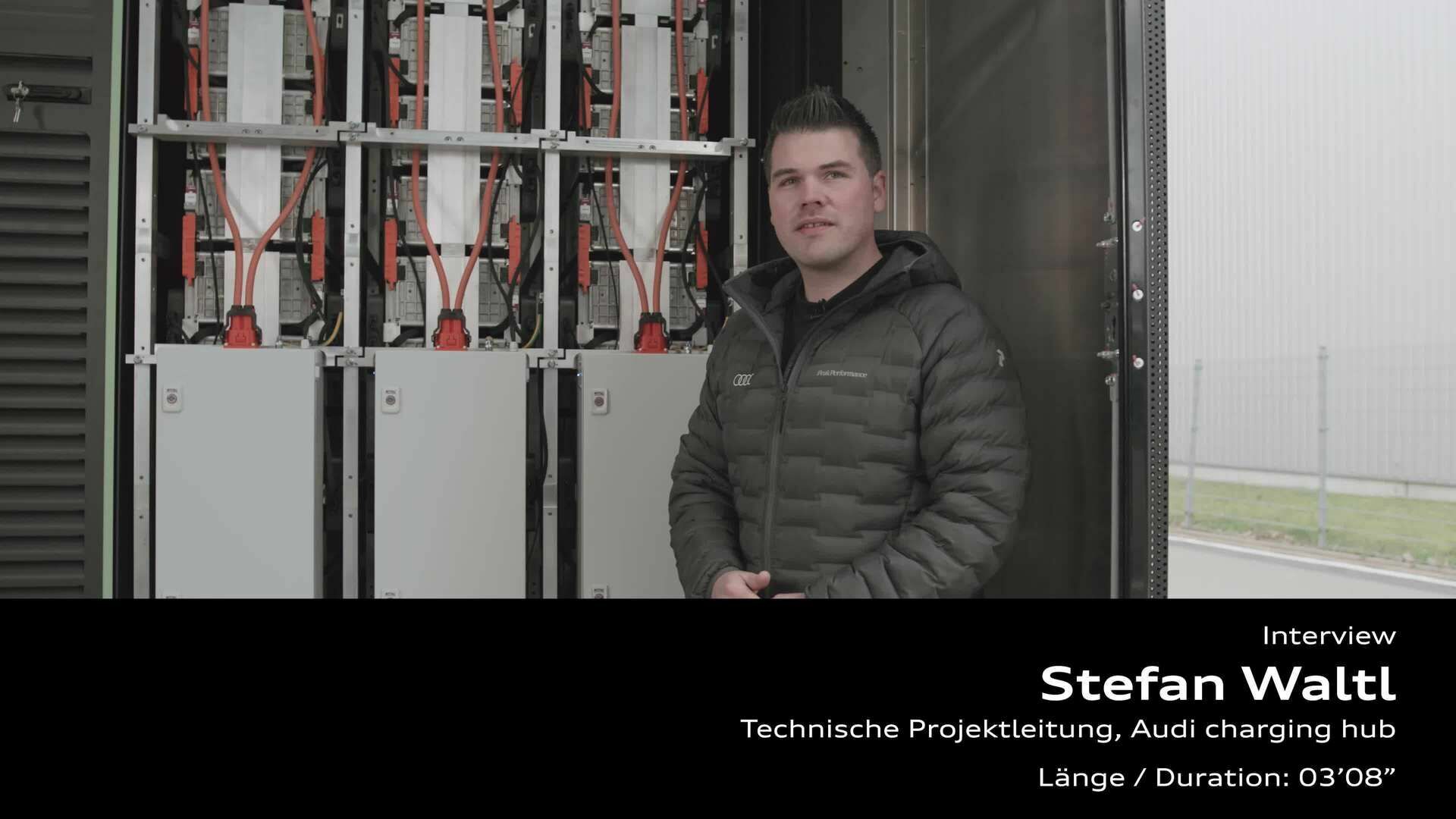Charging technology and infrastructure
Charging with green power: How Audi is making electromobility more sustainable
Electric cars do not emit carbon on the road. But the generation of electricity itself also produces carbon emissions – far more when the power is generated from fossil fuels than from renewable energy sources. For this reason, Audi will be directly working as intensively to expand the use of green power as it already does in building a green charging infrastructure. Audi’s vision of controlled charging, a grid-friendly concept by which electric cars charge when there is a surplus of renewable energy in the grid, is already set to become reality in a few years. Today, customers can already charge at home and on the road with green power from Volkswagen subsidiary Elli and joint venture IONITY. In addition, Audi is steadily expanding the self-sufficient and sustainable charging offer Audi charging hub, which uses lithium-ion batteries as buffer storage. These so-called second-life batteries are taken from dismantled Audi test vehicles.
Green power at all European sites
Audi aims to become a provider of carbon-neutral mobility and reduce the carbon footprint of its fleet by 30 percent over its life cycle by the year 2025. As such, not only has the use of green power been a mandatory component of supplier contracts with manufacturers of high-voltage batteries since 2018, but all of Audi’s European production sites exclusively source green power. Moreover, the company is partnering with energy providers in supporting the expansion of renewable energy sources to cover the power needs of the fully electric Audi fleet during the utilization stage.
New sites for renewable energy sources
Through this partnership, new wind and solar farms will be built in various European countries by 2025 that will altogether generate around five terawatt hours of additional green power. This corresponds to an installed capacity of about 250 new wind turbines. Audi plans to increase the share of electricity its partners generate from renewable sources in conjunction with an additional increase in the share of electric cars on the road. The partnership with energy suppliers is also intended to cover charging processes that aren’t yet carried out with green power today. In this way, Audi is actively involved in ensuring that its customers are on the move with green power in the future.
Green charging at home
When charging at home, Audi customers can use the green power solutions offered by Volkswagen subsidiary Elli. And for charging on the road, the IONITY charging network as well as many other charging point operators already rely on green power.
The e-tron charging system connect, designed to deliver up to 22 kW of power, lets customers with a compatible Home Energy Management System (HEMS) charge at low-cost times with a variable-rate electricity plan. If the home is equipped with solar panels, users can opt to prioritize charging the car with self-generated power. Forecast periods of sunshine are taken into account when planning the charging process.
IONITY relies on green power for sustainable charging on the road
The charging network from joint venture IONITY – n which Volkswagen, with its Porsche and Audi brands, has a stake – also relies on green power for on-the-road charging. IONITY operates in 24 European countries and plans to increase the number of high-performance 350 kW charging points from more than 1,500 at present to around 7,000 by 2025. In addition, they are no longer being built only along freeways, but also near major cities and along busy main roads. As a result, the number of charging locations is also increasing from just under 400 at present to more than 1,000. In addition, IONITY plans to expand many of the existing locations – depending on their utilization levels. New sites will be designed with six to twelve charging points right from the beginning.
Why Audi develops battery cells on its own
Audi’s battery testing center in Gaimersheim ensures an ideal balance is struck between energy density and charging capacity in the battery cells used in the e-tron models. Additionally, each vehicle project entails a variety of service life and fast-charging tests on several hundred cells.
The cells have to run through various charging and load profiles that the technicians perform in climatic chambers at temperatures between -30 and +60 °C. In order to assess the cells’ aging phenomena, they are also exposed to high temperatures for the space of about a year. This allows Audi to simulate an in-car service life of up to 15 years. Service life test stands in Gaimersheim also allow the technicians to speed up reconstructed mileage scenarios of about 300,000 kilometers. Other tests include crash and overcharge testing as well as various safety tests. As such, the battery cells meet the highest service life and safety standards – decisive criteria for sustainable use.
Buffer storage in the Audi charging hub
Thanks to the use of what are known as second-life modules – battery cells taken from dismantled development vehicles – the Audi charging hub is not only extremely sustainable. Another major advantage lies, above all, in the hubs’ capacity as buffer storage for direct current. This eliminates the need for a complex infrastructure with high-voltage power lines and expensive transformers. A supply of 220 kW of power from the grid is sufficient for the 2.45 MWh battery storage system and its six charging points, each with a capacity of up to 300 kW, at the pilot site in Nuremberg. With a green power contract in place, the Audi charging hub only uses energy from sustainable resources. Solar panels provide additional green energy.
The technology and modular design of the buildings not only make it easier to select possible locations. They also reduce the time required for planning, thereby cutting costs and conserving resources. Following the successful launch of the first Audi charging hub in Nuremberg, Audi is expanding its urban charging concept. Starting in the second half of the year, a second compact Audi charging hub pilot site will open in downtown Zurich, followed by sites in Salzburg and Berlin. Additional sites are slated to open in Germany in 2023 and mid-2024.
The symbiosis between e-mobility and renewable energies
For four years now, Audi has been electrifying Berlin. Like the Audi charging hub, the mutli-use storage system on Berlin’s EUREF Campus, with its capacity of 1.9 MWh, uses second-life lithium-ion from Audi development vehicles. In researching intelligent networking to promote the energy revolution, the site acts as a real-world laboratory by testing various interaction scenarios between electric cars and the energy grid. With a mere 20 second-life batteries, the EUREF storage system already meets 0.1 percent of Germany’s frequency stabilization needs. Audi identifies the greatest energy-economy potential in controlled charging at surplus times, i.e. periods when the grid has a surplus of renewable energy. As part of an ongoing research trial in Berlin, 18 virtual vehicles that drive for three hours and stand unused for 21 hours during a simulated day are charged intelligently using real electricity transactions on the power exchange. “In the future, the grid will determine when to charge a vehicle, without affecting its use,” says Alexander Kupfer, who is responsible for sustainable product development at Audi. The trial goes beyond controlled charging to also explore the vehicle-to-grid or V2G concept. The final vision is to achieve a symbiosis between electric cars and the power grid. Experts from Audi were able to demonstrate that in a scenario where renewable energies and e-mobility achieve 100 percent penetration, 90 percent of driving-related energy demand can be covered by surpluses of renewable energies. Conversely, this means that the energy sector will find in e-mobility a reliable customer for two-thirds of its renewable energy surpluses. “The energy revolution will be a joint effort. Our trial has shown that the energy sector and e-mobility will enter a symbiotic relationship that will drive the success of a power-based society. If we set the right course today, it won’t just be the energy system and the transport revolution that benefit. Ultimately, it will act as a crucial sustainability lever that will allow us to make the best possible use of existing resources,” says Kupfer.

Bidirectional charging technology
Renewables accounted for about 44 percent of Germany’s electricity mix in 2022. However, as the share increases, so do the challenges posed by wind and solar’s non-constant generation of power. On sunny days and during periods of high winds, there is often a lack of capacity to store the power that the grid cannot take. At the same time, the number both of mobile energy storage systems and registrations for electric cars are on the rise. The joint research approach pursued by Audi and the Hager Group, a pilot project for bidirectional charging, is contributing to increased supply security.
The battery in one Audi e-tron could supply a single-family home with power autonomously for around a week. In the future, Audi intends to exploit this potential alongside the even more important aspect of controlled charging at surplus times and make electric cars part of the energy revolution as a power storage system on four wheels.
As of: August 2023
